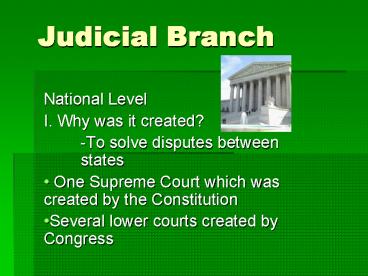Judicial Branch - PowerPoint PPT Presentation
1 / 26
Title:
Judicial Branch
Description:
One Supreme Court which was created by the Constitution ... way to overturn a Supreme Court decision is for them to ... Three ways cases come to Supreme Court: ... – PowerPoint PPT presentation
Number of Views:70
Avg rating:3.0/5.0
Title: Judicial Branch
1
Judicial Branch
- National Level
- I. Why was it created?
- -To solve disputes between states
- One Supreme Court which was created by the
Constitution - Several lower courts created by Congress
2
II. Types of Courts
- Constitutional Courts
- Supreme Crt, Crt of Appeals, District Crt.
- They have Broad Judicial Power
- Special Courts
- Tax Court, Military Appeals Court
- Hear only specific types of cases.
- Dual System
- 100 Federal courts and 1,000s of State courts
work together
3
III. Jurisdiction
- Exclusive- Heard in Fed. Courts only
- Concurrent- Heard in State OR Fed. Crts
- Original- Hear cases for the first time
- Appellate- Hear cases on appeal
- Federal courts have original jurisdiction
- Subject Matter
- Parties (state vs. state person vs. state)
4
IV. U.S. Supreme Court
- One Chief Justice
- Eight Associate Justices
- Number set by Congress, can be changed
- Judicial Review- Judging the constitutionality of
a law. - Last resort in ALL questions of federal Law
5
Judicial Review
- Not mentioned in the Constitution!!
- Thus, no check against Judicial Review
- John Marshall gave himself the power in the case
of Marbury vs. Madison - These 9 people have TONS of power
- Only way to overturn a Supreme Court decision is
for them to change their minds.
6
- John Roberts
- Chief Justice
7
- Clarence Thomas
- Only current African
- American Justice
8
- Ruth Bader Ginsburg
- Only Current Woman
- on Court
9
- Antonin Scalia
- Assoc. Justice
10
- John Paul Stevens
- Oldest member of
- Court
11
- Steven Breyer
- Associate Justice
12
- David Souter
- Associate Justice
13
- Sam Alito
- Associate Justice
- Newest member
14
- Anthony Kennedy
- Associate Justice
15
V. Jurisdiction of Supreme Court
- Both original and appellate, but most come from
appeals. - Two types of cases fall under original
- State vs. a state
- Cases involving ambassadors, emissaries, etc.
16
VI. Cases Reaching the Supreme Court
- 5,000 are appealed, only 150 get heard.
- Turned away for two reasons
- Denial- Justices agree with lower court decision
- Remand- Returned to a lower court citing a recent
Supreme Court decision (precedent)
17
VII. Three ways cases come to Supreme Court
- Writ of Certiorari- claiming an error was made in
the lower court - Appeal- asking to review a lower court decision
- Certificate- A lower court is confused and asks
Supreme Court for help
18
VIII. Meet the Justices
- Chief Associate
- John Roberts John Paul Stevens- Oldest
- Ruth Bader Ginsburg-Woman
- Stephen Breyer
- Clarence Thomas- A-A
- Antonin Scalia
- Anthony Kennedy
- Samuel Alito
- David Souter
19
IX. Appointed to Sup. Crt.
- Appointed by Pres, approved by Senate
- Picked from leading State Justices or lower
Federal Court Justices - Pres. picks ones with same ideaology
- They serve a life term with good behavior
- Can be impeached (13 w/ 7 being removed)
- CompensationCongress sets salary
- Full retirement
20
X. Lower Federal Courts
- 1. District Courts-
- Federal trial courts-- 80 of workload
- 89 courts in 50 states- 563 Judges
- Created by Congress
- Each district has at least 2 Judges, some more
- Jurisdiction is original in most cases
- Hear both civil and criminal cases
21
(No Transcript)
22
Lower Federal Courts (cont.)
- 2. Court of Appeals
- Created by Congress to relieve Supreme Court of
heavy workload - 12 Court (11 Circuits and 1 in D.C.)
- Judges sit on a panel of three mostly
- Jurisdiction is appellate only!
23
(No Transcript)
24
XI. Special Courts
- 1. U.S. Claims Court
- If you want to sue the U.S., you go here
- We can only sue for certain reasons
- 2. Court of Military Appeals
- Hear appeals of court marshals
- 3. U.S. Tax Court
- Hear cases involving tax laws- I.R.S.
25
- Court of Veterans Appeals
- Hear cases where veterans feel their benefits
have been mishandled - Territorial Courts
- Courts for our U.S. territories
- All judges serve 15 year terms
- Appointed by President approved by Senate
26
XII. Opinions
- Majority Opinion- written for the majority
detailing why they voted in favor - Dissenting Opinion- written for the minority
stating why they voted against - Concurring Opinion- (majority or dissenting )
written to agree with one side BUT for different
reasons































